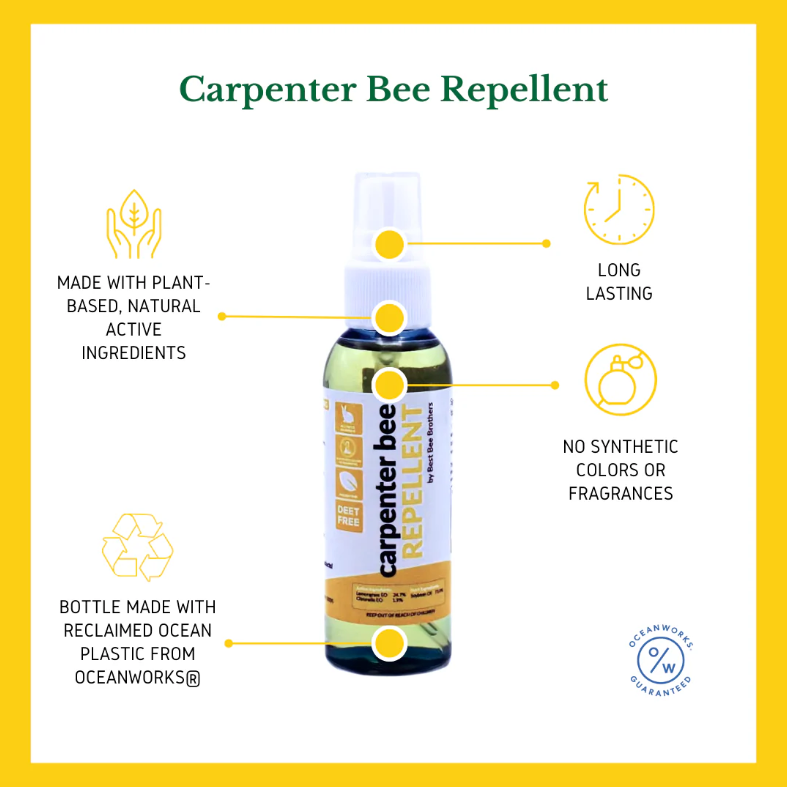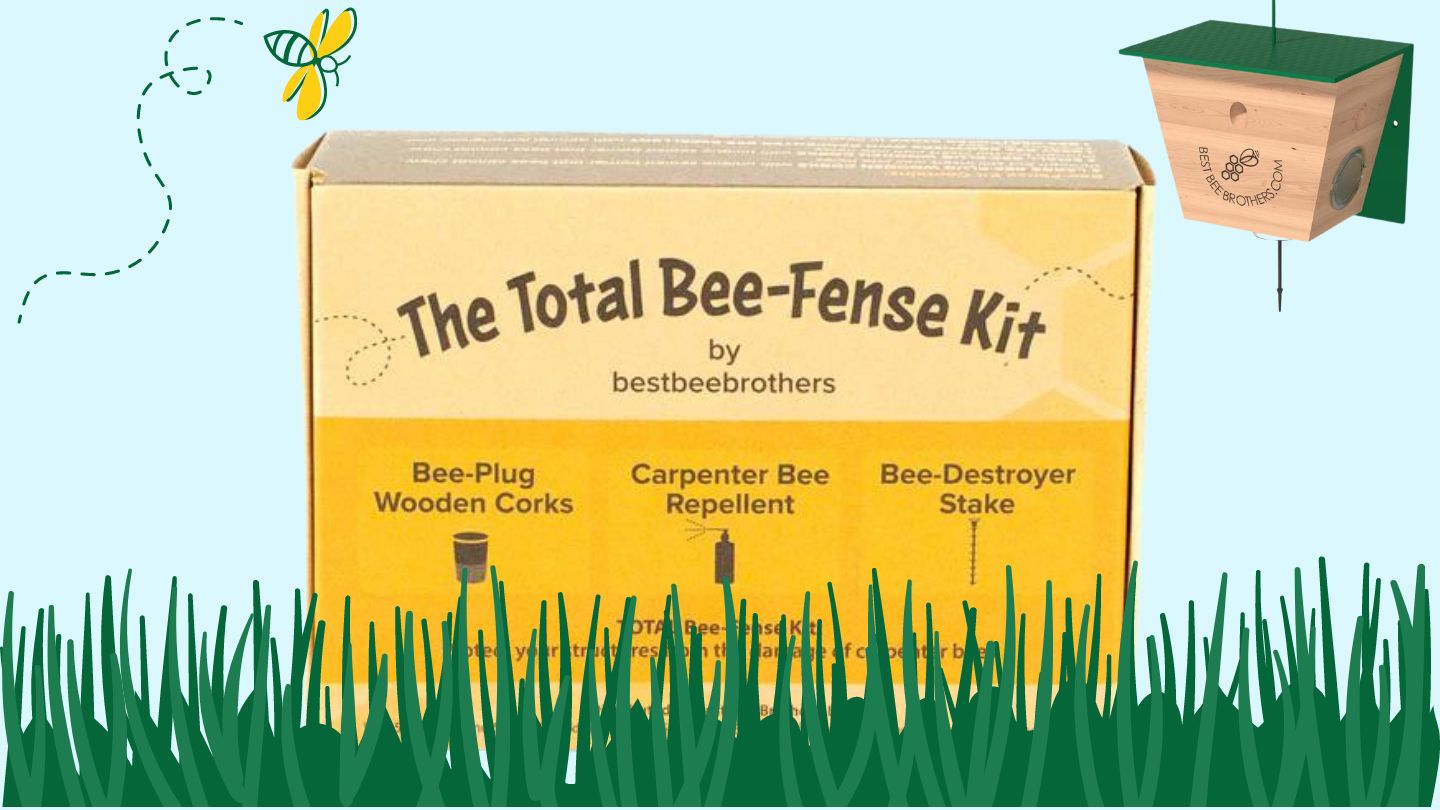How to Trap Carpenter Bees

If you’ve come to this page, you probably have some serious issues with these pesky little wood-boring creatures. Despite their small size, insects like carpenter bees can cause serious damage to the structural integrity of your home, not to mention ruin your outdoor living space. To get your home back in order as quickly as possible, we’ll break down our three-part process for ridding your home of carpenter bees.
How to Catch Carpenter Bees
- Understand Their Habits. Luckily for us, carpenter bees are fairly predictable in their mating and nesting habits. Generally speaking, they prefer soft, untreated wood like pine that’s easy for them to burrow in and lay their eggs.
- Buy a Trap.The first step to trapping carpenter bees is … well … buying a trap! What makes Best Bee Brothers® traps different from anything else on the market? Our traps use biomimicry to replicate the natural look and feel of a carpenter bee home. Our traps are made of soft composite plywood that is perfect for bees to nest in (or so they think). How do our traps catch bees? Once you set up your trap, it will attract carpenter bees looking for a nest. They’ll enter the trap and crawl down to the plastic container at the bottom of the trap – it’s the only light source in the structure! Once in the container, they cannot get out.
- Hang It Vertical, Sunny and High.After you’ve bought a trap or traps for carpenter bees, there are a few things to know. First, these traps are designed to work best when hung vertically. This may sound obvious, but it can make a significant difference in the number of carpenter bees that you catch. Make sure your trap is upright after you hang it and not tilted to one side or another. Second, carpenter bees love the sun, so choose an area outside your home that gets a lot of sunlight throughout the day to maximize the trap’s potential. And last, think about the placement itself. We recommend hanging or mounting the traps in the corners and peaks of your home’s structure.
- Bait It? No Way.Lastly, it’s time to bust a myth. Contrary to popular belief, baiting a carpenter bee trap is not necessary, but can be helpful. Interestingly enough, nothing entices a carpenter bee more than the pheromones of other dead carpenter bees. Why? It acts as a sort of homing beacon to say, “If this spot was a good nest for another carpenter bee, then it’s good enough for me.” So the sooner you get the traps up, the sooner you’ll start collecting dead carpenter bees that will release more pheromones.

How to Kill Carpenter Bees
Sit Back and Relax. Whew! The hard part is over. Once your Best Bee Brothers trap is set up and hung correctly, there’s nothing left for you to do but sit back and let it work its magic. It varies from home to home, but most people begin seeing results within the first few days of their traps being hung. Remember, all you need is one dead carpenter bee in your trap to get the ball rolling with those pheromones.
What Kills Carpenter Bees Instantly?
We have good news for you! You have other options to kill carpenter bees instantly besides pesticides and other toxic chemicals. If you don’t want to wait for our carpenter bee traps to do the trick, a few naturally derived options can take care of your wood bee problem quickly.
While we use essential oils like lemongrass and citronella in our carpenter bee repellent, these natural actives are meant to prevent rather than eliminate carpenter bees. If you already have an infestation, check out the following methods for killing bees that are already boring into your wood:
- Consider using diatomaceous earth on carpenter bee larvae and nests. This silica-based mineral does not contain pesticides, but it requires caution. While it’s considered safe for humans and pets, you’ll want to avoid inhaling it. Wear gloves, goggles and a respirator when sprinkling this dust in and around nest sites. When applied properly, diatomaceous earth can kill carpenter bees within minutes.
- Our Bug Zapper Racket kills carpenter bees on contact with a powerful electric shock. Typically, airborne targets are males, so truly ridding yourself of this pest also requires eliminating the nesting females.
- Boric acid is another quick-kill option for a carpenter bee infestation. Though this chemical is not synthetic, it’s strong! It must be diluted 3:1 (three parts water, one part boric acid). As with diatomaceous earth, when spraying boric acid in carpenter bee nests, you need to protect your skin and eyes. Wear long sleeves, gloves and protective eyewear, and keep your children and pets away while you take care of the nests. While boric acid will not kill carpenter bees immediately, it doesn’t take long – about an hour or so.
- Once you’ve killed the carpenter bees on your property, it’s important to plug the nests. These nesting sites are often not empty for long, and preventing new “residents” is essential.

How to Keep Carpenter Bees Away
Your traps for carpenter bees are working great, and you’re starting to see progress - dead bees! Now how do you keep it that way? For this step, we recommend two things:
- Best Bee Brothers Citrus Spray. Did you know that carpenter bees hate citrus? Our chemical-free, handcrafted batch of citrus spray is nothing less than repulsive to these critters and will definitely make them think twice about visiting your home.
-
Treat Current Nests. Carpenter bees will be lazy if they can be. That’s why it’s vitally important to scan your home for preexisting carpenter bee nests to ensure that your bees aren’t trying to renovate an old nest. Once you locate these old or currently active nests, here’s your game plan:
-
Fill Holes
Treat any holes by clogging them with plugs, wooden corks, putty or even a caulking compound. - Paint and Stain
Because carpenter bees prefer untreated wood, applying a coat of primer, paint, and/or stain can help deter them from settling in. -
Hang Traps
Once you figure out how many traps are needed (each trap has a 15 ft. working radius), it’s time to put them up! Check out our helpful guide on where to place your traps for best results. -
Jump Start Your Trap
Start attracting bees to your traps by placing a dead carpenter bee inside the trap. If you’re unable to do this, don’t worry– we’ve got you covered.
-
Fill Holes
Find detailed instructions on defending against carpenter bees here.

Your Best Bee-Fense Against Future Wood Damage
Our Total Bee-Fense Kit comes with everything you need to prepare for Carpenter Bee Season. Our customers have found that using the kit along with our Turbo Traps yields the best results.
How does it work?
Once you’ve located existing nests, here’s what to do next:
Step One:
Spray the citrus carpenter bee spray 3–4 times into each entry hole. If you notice activity around the nests, wait until the bees are less active. Holding off until after sundown is generally advised, since carpenter bees are not as active at night.
Step Two:
Wait 4–5 minutes to observe whether any carpenter bees emerge.
Step Three:
Once empty, insert the Bee-Destroyer Stake into each carpenter bee hole several times, as far as it will reach. This will destroy any existing pollen plugs, which is where carpenter bee larvae can be found. The Bee-Destroyer Stake works most effectively if inserted and twisted at the same time to ream the inside of the nest and crush any larvae.
Step Four:
Finally, it’s time to seal up the nest for good. Insert a Hand Dipped Wooden Cork, placing the rubberized end into each nest hole to fill the entrance, creating a barrier that carpenter bees can’t chew through. You’ll want to continue pushing the wooden cork into the hole, until the rubber is flush with the adjacent wooden surface, or as near to flush as possible. Be sure to refinish or repaint the surface to match the existing exterior.
Now that you’ve completed all the steps, it’s time to take back your home and start enjoying these wonderful spring and summer months while they last! Happy trapping!
